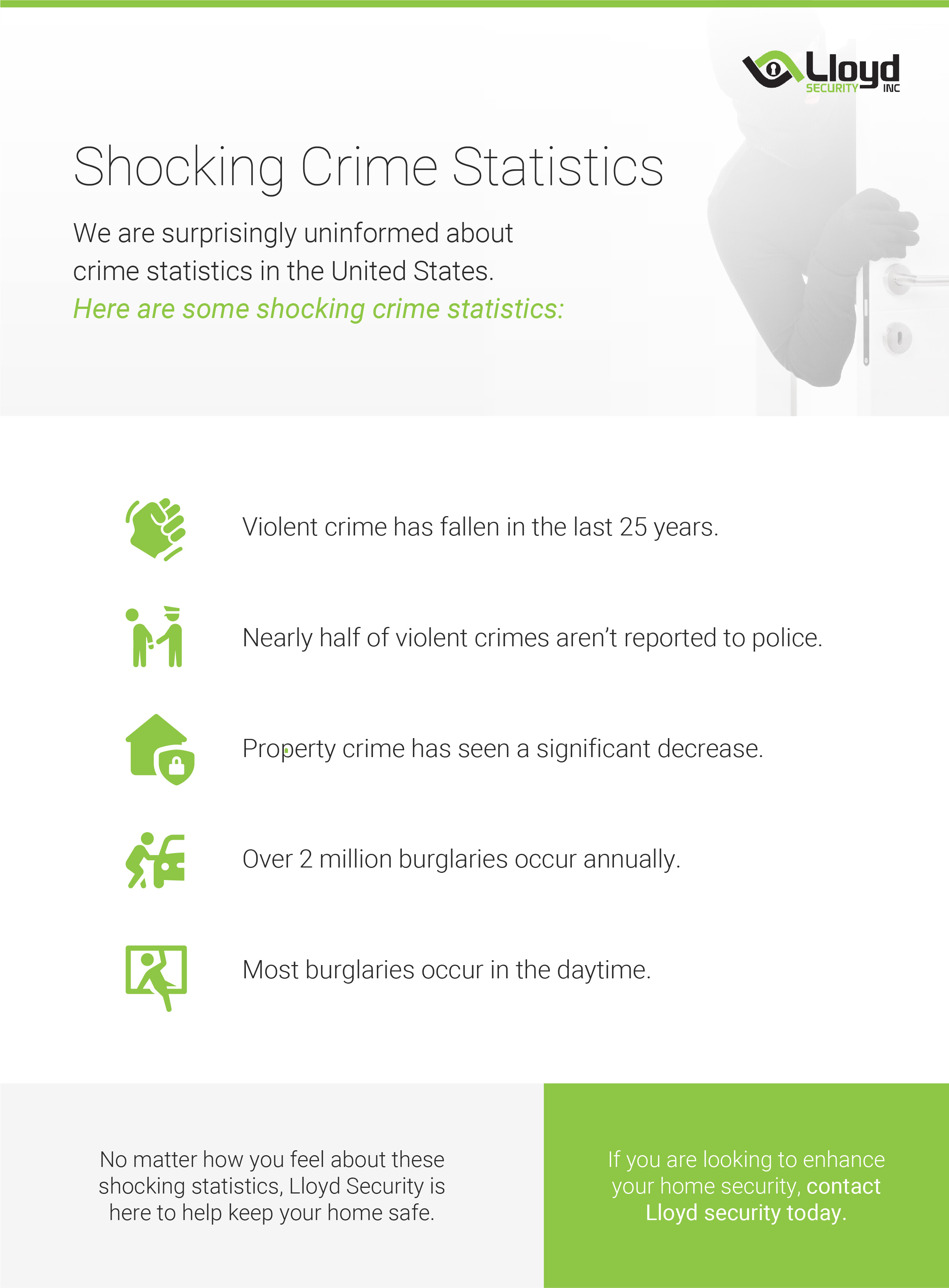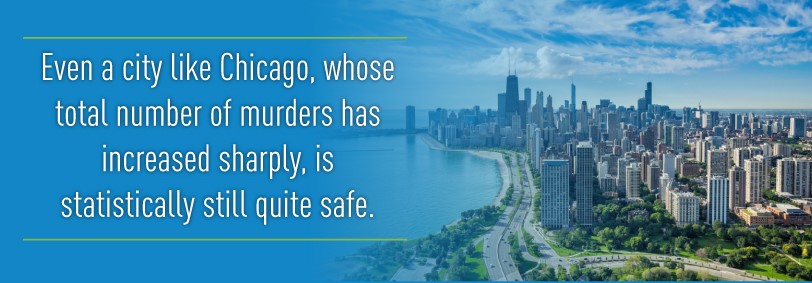
Table of Contents
- Violent Crime Has Fallen in Past 25 Years
- Property Crime Has Been on the Decrease
- Crime Varies with Geography
- Firearm Use is Lower, But Accounts for Same Amount of Crime
- Nearly Half of Violent Crimes Aren’t Reported
- Public Opinion on Crime Doesn’t Reflect Data
- Over 2 Million Home Burglaries are in the US Each Year
- Most Burglaries are During the Daytime
Crime is a hot topic on the public stage these days. It has long been a talking point for politicians, as they understand it is deeply linked with our fears and actions. The feeling of dread that accompanies rising crime rates creeps insidiously into the backs of our minds, making it a source of stress — and an effective tool for political maneuvering.
The fact is that we are frequently, and regrettably, misinformed about United States crime statistics. This misinformation stems from multiple causes, but political gain is one of the chief culprits. When we’re told crime is on the rise, we’re more likely to seek a solution from those who claim to offer one.
In a world of incessant broadcasting and social media echo chambers, it’s harder than ever to discern which statements are true and which are simply designed to appeal to our emotions.
That’s why these surprising facts about crime may come in handy. While some United States security statistics are misreported entirely, there are also dangers that don’t get as much attention. Let’s look at eight facts about crime that may come as a surprise, as well as effective ways to keep yourself safe.

1. Violent Crime Has Actually Fallen in the Last 25 Years
This statistic is at the top of our list because it seems to be one of the largest gray areas among our understanding of crime in the United States.

Between 1993 and 2015, the crime rate has decreased by between 50 and 77% — the former figure cited by the FBI, and the latter by the Bureau of Justice Statistics. These two institutions monitor crime around the country by taking surveys of 18,000 jurisdictions and 90,000 households, respectively, and it is useful to look at both numbers to get an idea of the truth.
The likely source of claims that crime is on the rise is a slight increase in violent crime over the last few years. This rise is largely attributable to the spike in violent crime in certain large urban areas, which tends to skew the national average heavily. We should also note that some urban areas have seen a marked increase in violent crime, while others have seen a decrease.
As an oft-cited example, Chicago saw an unfathomable 59% increase in murder in 2016. However, keep in mind that this isolated spike in crime was single-handedly responsible for boosting big cities’ murder rate by a considerable 40%. Other cities like Memphis, Anchorage and San Antonio saw similar increases, but it certainly wasn’t the case for all metropolitan areas.
The conclusion is that violent crime, while rising a bit in the short-term, has been following a steady downward trend for the last quarter century. The small, recent upward trend is mostly due to localized problems, so any talk of the national crime rate rising is unfounded — or at the very least, not terribly useful.
2. Property Crime Has Seen a Significant Decrease
Property crime includes instances of burglary, robbery, arson and theft of motor vehicles. Following suit with violent crime, property crime has also seen a dramatic decrease in the last quarter century. From 1993 to 2015, it dropped anywhere from 49 to 69%, according to the FBI and BSJ, respectively.
Trying to pinpoint the cause of crime decrease can be a fruitless endeavor. Any time it looks like a causal relationship has been discovered, some other piece of evidence stands in glaring opposition. Some theories include the decreased presence of lead in our daily lives, the varying consumption of alcohol, the overall economy, the rate of incarceration and the strictness or leniency of police.
However, each of these theories can be easily countered by contrasting evidence or data. So, while it is an interesting thought exercise, the important takeaway is simply that property crime is decreasing. Remember that old rule of science: Correlation does not equal causation.
There is one factor that is certain, though. The use of alarm and home security systems plays a large role in decreasing property crime.
Burglars are drawn to homes that don’t use security systems, as they have a much lower chance of being caught in the act. Installing one in your home that features high-tech components including motion sensors, access control systems, security cameras or glass break sensors can greatly reduce your risk of home invasion.
3. Crime Rates Vary Vastly With Geography
Perhaps we’re hammering this point a bit, but it bears repeating. National crime rates do not affect everyone — or every place — equally. Some places in the United States enjoy a very low rate of both violent and property crime, while others seem to endure the most of its unpleasantness.

For example, states like Alaska, Tennessee and Nevada sport a crime rate around 0.6%, while others like Vermont, Virginia, Maine and New Hampshire are only one third of that. Even a city like Chicago, whose total number of murders has increased sharply, is statistically still quite safe. In 2015, a year of drastic increase in the city’s homicides, its murder rate was still significantly less than that of Baltimore or St. Louis.
Crime rates vary with factors like population density and a place’s economic situation. Some of the most peaceful and safe states to live in are in the northeast, while states like Louisiana and Mississippi have some of the worst crime rates in the nation.
As stated before, it’s nearly impossible — and inadvisable — to try to tie varying crime rate to any single factor. However, there are several contributing elements that seem to hold water. Education is one of them, as areas with higher rates of education almost universally tend to suffer less crime. Another is economic affluence, though there are also contradictions to this rule, such as the lack of a crime spike during the Great Depression.
There are even some twists to this narrative, though. While it is often believed cities are less safe than suburban and rural areas, there is convincing evidence that city life may actually be safer. When you weigh all the dangers together, it appears being closer to other people could contribute to an overall increase in safety.
4. Though Firearm Use Is Lower Than in the 1990s, It Still Comprises the Same Percentage of Crimes
In 1993, the number of firearm incidents in the United States was over 1.2 million. In 2011, less than two decades later, it had fallen to just over 400,000 — a very encouraging trend that correlated with the overall decrease in crime in the country.
However, another interesting trend emerged next. Even throughout the changing times, firearm crimes hovered right around 8% of all violent incidents. This means the percentage of gun crimes has stayed intact, at least relative to overall crime. The firearm crime rate of the nation, mercifully, has dropped significantly.
Less surprising is the fact that guns remain the weapon of choice in cases of homicide — in 2015, they were used in nearly three-quarters of all murders. Around 40.8% of robbers used them, while aggravated assaults involved guns just under a quarter of the time.
The takeaway here is that, although the number of firearms crimes has gone down by a great deal, the same chunk of crimes still use them. Furthermore, violent crimes like murder, robbery and aggravated assault still overwhelmingly involve them.
In your day-to-day life, the best ways to stay safe from the threat of firearms are to be aware of your surroundings and to keep your home protected with a security system. When you’re walking alone, keep your eyes and ears open to avoid being caught by surprise and out of sight of others. At home, make sure your alarm system is on and working properly — doing so may save you from having a scrape with an armed intruder.
5. Nearly Half of Violent Crimes Aren’t Reported to Police
This unfortunate truth is at the heart of much suffering and unsolved injustice. People often don’t report crimes to the police, and it happens for a myriad of reasons:
- A feeling that the police will not be able to help them
- The personal nature of the crime
- A fear that police involvement may somehow land them in trouble

Violent crimes are reported in slightly different numbers. For those violent crimes that can be categorized as serious, around 45% go unreported. Serious domestic violence is reported slightly more, with only 39% going unreported — though this is still far too much. When injury is involved in the violent crime, the unreported rate is 41%, and those crimes involving weapons are only reported 56% of the time.
Emotional distress and confidence in police play important roles in whether crimes get reported. If victims feel a large amount of stress over an incident, they are statistically more likely to report the crime. However, a person’s ingrained perception of police can greatly affect whether they go to them and how likely they are to be satisfied with the response.
6. The Public’s Opinion on Violent Crime Doesn’t Reflect the Data
When crime is down, it seems people have a hard time believing it. In a poll conducted in 1989, many citizens stated they believed crime had risen in the previous year, even though evidence from the FBI and BSJ showed it had decreased.
This was not a trend isolated to the late 80s, however — another poll in 2016 determined 57% of voters believed that, since 2008’s financial recession and presidential election, crime had grown worse. In fact, crime dropped quite a bit between 2008 and 2016, and the data showing so is freely available.
Even though some political candidates fan the flames of perceived crime rates more than others, there is a vast misconception across the whole political spectrum. In the 2016 election, only 15% of all voters believed crime rates had improved since 2008 — that is a startling 85% of voters who believed crime had either stayed the same or gotten worse, when in fact violent crime fell by 19% and property crime by 23%.
The best way to combat misinformation is to fact-check all claims. It’s difficult to remove emotion and bias from our outlooks, but it’s the first step in countering the onslaught of propaganda that besieges us.
7. Over 2 Million Home Burglaries Occur Annually in the United States
While crime has decreased encouragingly, property crime is still prevalent. To protect your home from invasion and robbery, it’s important to understand how burglars target and rob homes. Here are some facts about robberies and crimes to help you make sense of it:
- Two thirds of all burglaries are residential home break-ins.
- 30% of home robberies occur when a burglar enters through an open or unlocked door or window, thereby giving them quiet and easy entrance into a home.
- Renters and homeowners are equally likely to attract burglars — they do not seem to target one over the other.
- 7% of home robberies end with the owner falling victim to violence.
- Summer is prime time for robberies.
- Burglars stole over $14 billion in valuables from residencies in 2015 alone.
- Burglars avoid homes with alarm systems.
That last point is an important one, and is actually a vast understatement. In fact, homes with no alarm systems are 300% more likely to be burglarized than homes with them. That is a discrepancy that is difficult to argue against.
The loss of valuables, mementos, jewelry and money is a tragic reality that affects Americans every day. Alarm systems minimize the risk of loss by presenting an ominous threat to robbers. Unfortunately, many people hesitate to install them for fear of exorbitant costs, or because they believe their home is not at high risk of burglary.
8. Most Home Burglaries Occur in the Daytime
The weather is nice, the windows are open and the birds are singing. Unfortunately, robbers may also be waiting for an unsuspecting homeowner to leave the door open — both figuratively and literally.

Most instances of home burglary take place between 10AM and 3PM, and 30% of the time when someone is at home when it happens. Most burglaries are quick. Burglars will often enter through the front door, head straight to the master bedroom, and be gone in less than 10 minutes.
We often imagine burglaries to take place during the nighttime, when in fact we may have our guards down more during the day. A strange vehicle parked on the street seems a lot more innocuous when the sun is shining, and oftentimes burglars can enter and leave someone’s home completely unnoticed.
Another shocking statistic is that, 65% of the time, victims know the robbers personally. This is because robbers will frequently use information about the victim’s lifestyle and schedule against them when planning a theft.
Remember, the daytime is more likely to coincide with a robbery, so take measures to make your house unappealing to robbers. Keep the doors closed and locked, and remember to secure your house any time you leave.
Contact Lloyd Security for Security Systems in Minnesota to Maximize Your Home’s Security
For all your home security needs, call Lloyd Security. It’s time to take that 300% leap in the right direction when it comes to the safety of your home, family and possessions — and it’s as easy as visiting our contact page.
Lloyd has a wide variety of different, high-tech home security features. We offer security cameras, motion detectors, door and window alarms, glass breakage detectors, access control systems, freeze sensors, flood sensors and fire alarms.
Contact us today to make your house an unattractive threat to burglars and protect your hard-earned treasures for years to come.
